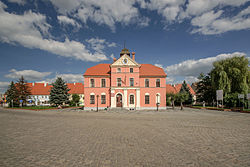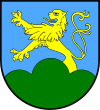Lewin Brzeski
| Lewin Brzeski | |||
|---|---|---|---|

|
|||
|
|||
| Coordinates: 50°44′59″N 17°37′8″E / 50.74972°N 17.61889°E | |||
| Country |
|
||
| Voivodeship | Opole | ||
| County | Brzeg | ||
| Gmina | Lewin Brzeski | ||
| Area | |||
| • Total | 10.35 km2 (4.00 sq mi) | ||
| Elevation | 145 m (476 ft) | ||
| Population (2011) | |||
| • Total | 5,940 | ||
| • Density | 570/km2 (1,500/sq mi) | ||
| Postal code | 49-340 | ||
| Website | http://www.lewin-brzeski.pl | ||
Lewin Brzeski [ˈlɛvʲin ˈbʐɛskʲi] (German: Löwen) is a town in Brzeg County, Opole Voivodeship, Poland, with 5,843 inhabitants (2004).
Located along the medieval trade routes from Silesia to Hungary, by the Amber Road and the Nysa Kłodzka, the town of Lewin first grew up in the Middle Ages as a market town. It is first mentioned in a contract from 1257, when a monastery run by the Knights Hospitaller in Łosiów purchased a mill near the town. It was also mentioned by the moneylender Walter von Lewin that the dukes of Opole. As early as the mid-13th century the city had received Magdeburg Rights, a type of German town law that granted the town a certain amount of autonomy. The town was built around a rectangular marketplace, and surrounded by a rampart with a palisade with a ditch below it that could, if necessary, through the opening of a lock could be filled with water from the Neisse. In addition, there were four city gates. In 1333 the town was granted new rights and privileges, such as the brewing of beer and the holding of Wednesday markets, by Duke Boguslaus of Brieg, as Lewin switched between the duchies of Liegnitz and Brieg and, both of which had already by 1329 come under the suzerainty of the Bohemian crown.
The 16th century brought an economic boom to the city. In 1526 the city passed to the Habsburgs, and since 1592 yearly fairs were organized with the permission of the duke of Brieg. After the Reformation Löwen became mainly Protestant, and the Catholic parish was disbanded. During the Thirty Years War the town was looted, burned, and struck by the Plague. In 1742 Löwen became part of Prussia, by then a town of almost 700 people. Several town fires burned the city, the most devastating in 1829, which destroyed the wooden buildings completely and ushered in a fundamental reconstruction of the city. The city was rebuilt with stone buildings, such as the neoclassical Town Hall built in 1837 on the Ring.
...
Wikipedia



